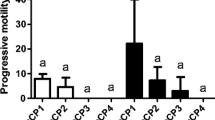Abstract
Three mouse embryo bioassays [mouse one-cell and two-cell embryos and in vitro fertilization (IVF)] were tested for their ability to discriminate between three sources of water for medium preparation: tap water, high-performance liquid chromatography (HPLC)-grade water, and Milli-Q purified water. No differences could be detected using these assays. The lack of sensitivity of the mouse bioassays could not be attributed to the protein source or medium type. The hamster sperm motility assay (HSMA) permitted quantitative discrimination between water sources (Milli-Q > HPLC > tap). Media prepared for use in human IVF using water that exceeded minimal HSMA quality standards resulted in pregnancy rates that were greater than those attained with a lot of HPLC water that did not meet these standards. The HSMA can serve as a basis for a quality-control program in the human IVF laboratory.
Similar content being viewed by others
References
Whittingham DG: Culture of mouse ova. J Reprod Fertil (Suppl) 1971;14:7–21
Fukuda A, Noda Y, Tsukui S, Matsumoto H, Yano J, Mori T: Influences of water quality on in vitro fertilization and embryo development for the mouse. J Vitro Fert Embryo Transfer 1987;4:40
Ackerman SB, Stokes GL, Swanson RJ, Taylor SP, Fenwick L: Toxicity testing for human in vitro fertilization programs. J Vitro Fert Embryo Transfer 1985;2:132
Parinaud J, Reme J, Monrozies X, Favrin S, Sarramon M, Pontonnier G: Mouse system quality control is necessary before the use of new material for in vitro fertilization and embryo transfer. J Vitro Fert Embryo Transfer 1987;4:56
Silverman IH, Cook CL, Sanfilippo JS, Yussman MA, Schultz GS, Hilton FH: Ham's F-10 constituted with tap water supports mouse conceptus development in vitro. J Vitro Fert Embryo Transfer 1987;4:185
Bavister BD, Andrews JC: A rapid sperm motility bioassay procedure for quality control testing of water and culture media. J Vitro Fert Embryo Transfer 1988;5:67–75
Lapata A: Concepts in human in vitro fertilization and embryo transfer. Fertil Steril 1983;40:289–301
Biggers JD, Whitten WK, Whittingham DG: The culture of mouse embryos in vitro.In Methods in Mammalian Embryology, JC Daniel (ed). San Francisco, W. H. Freeman, 1971, pp 86–116
Quinn P, Warnes GM, Kerin JF, Kirby: Culture factors in relation to the success of human in vitro fertilization and embryo transfer. Fertil Steril 1984;41:202
Gerrity M: Mouse embryo culture bioassay.In In Vitro Fertilization and Embryo Transfer: A Manual of Basic Techniques, DP Wolf, BD Bavister, M Gerrity, G Kopf (eds). New York, Plenum Press, 1988
Bavister BD, Yanagimachi R: The effects of sperm extracts and energy sources on the motility and acrosome reactions of hamster spermatozoa in vitro. Biol Reprod 1977;19:228
Bavister BD: The effect of variations in culture conditions on the motility of hamster spermatozoa. J Reprod Fertil 1974;38:431–440
Cholewa JA, Whitten WK: Development of two-cell mouse embryos in the absence of a fixed nitrogen source. J Repord Fertil 1970;22:553
Wramsby H, Fridga K, Liedholm P: Chromosome analysis of human oocytes recovered from preovulatory follicles in stimulated cycles. N Engl J Med 1987;316:121
Edmonds DK, Lindsay KS, Miller JF, Williamson E, Wood PJ: Early embryonic mortality in women. Fertil Steril 1982;38:447
Schlesselman JJ: How does one assess the risk of abnormalities from human in vitro fertilization? Am J Obstet Gynecol 1979;135:135
Jones HW, Jones GS, Andrews MC, Acosta A, Bundren C, Garcia J, Sandow B, Veeck L, Wilkes C, Witmyer J, Wortham JE, Wright G: The program for in vitro fertilization at Norfolk. Fertil Steril 1982;38:14
Chetkowski RJ, Nass TE, Matt DW, Hamilton F, Steingold KA, Randle D, Meldrum DR: Optimization of hydrogen-ion concentration during aspiration of oocytes and culture and transfer of embryos. J Vitro Fert Embryo Transfer 1985;2:207
Yovich JL, Edirisinghe W, Yovich JM, Stanger J and Matson P: Methods of water purification for the preparation of culture media in an IVF-ET programme. Hum Reprod 1988;3:245–248
Trounson A, Conto A: Research in human in vitro fertilization and embryo transfer. Br Med J 1984;285:244
Fleming TP, Pratt HPM, Braude PR: The use of mouse preimplantation embryos for quality control of culture reagents in human in vitro fertilization programs. A cautionary note. Fertil Steril 1987;47:858
Arny M, Nachtigall L, Quagliarello J: The effect of preimplantation culture conditions on murine embryo implantation and fetal development. Fertil Steril 1987;48:861
Reust J, Meyer V: Determination of organic contaminants in ultra-pure water by reversed-phase high-performance liquid chromatography with ultraviolet detection. Analyst 107:673–679
College of American Pathologists, Commission on Laboratory Inspection and Accreditation: Reagent water specifications.
Galber R, Hegde R, Hughes D: Degradation of high purity water on storage. J Liq Chromatogr 1983;6:2565–2570
Spindle AI, Pedersen RA: Hatching, attachment and out-growth of mouse blastocysts in vitro; Fixed nitrogen requirements. J Exp Zool 1973;186:305–318
Author information
Authors and Affiliations
Rights and permissions
About this article
Cite this article
Rinehart, J.S., Bavister, B.D. & Gerrity, M. Quality control in the in vitro fertilization laboratory: Comparison of bioassay systems for water quality. J Assist Reprod Genet 5, 335–342 (1988). https://doi.org/10.1007/BF01129569
Received:
Accepted:
Issue Date:
DOI: https://doi.org/10.1007/BF01129569




